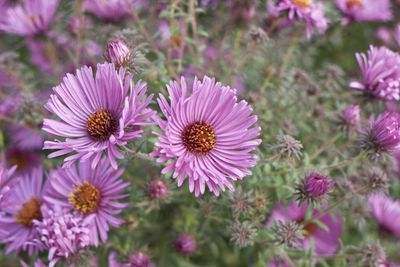How Many Kinds of Aster are There?
Most gardeners are familiar with asters. These workhorses in the autumn garden brighten the landscape even as most perennials are fading. There are many different types of aster from which to choose, most of which thrive in temperate to cool season climates. As native plants, they are adaptable to many sites, but do seem to prefer full sun and well-drained soil. Both the New England and New York asters are native to North America and thrive in a wide range of growing conditions. New England aster has full, plump blooms and thick, woody stems while New York aster has smooth leaves and thinner stems. Asters come in uncountable cultivars, but most are perennial. Among these are classifications such as heath, aromatic, smooth, calico, and wood. Sizes range from 1 to 6 feet in height (31 cm. to 2 m.), with New England varieties the tallest. Height, bloom color, and bloom time are all defining factors when choosing different types of aster. Most bloom late summer to early fall. New York asters are also known as Michaelmas daisy and bloom in fall while New England asters are known to bloom earlier in mid to late summer. New York asters come in cooler colors of blue, indigo, white, violet, and occasionally pink. New England forms will astound with hues of reds and rust along with the cooler tones. New York cultivars have darker green foliage while the other varieties come with slightly hairy medium green to almost a grayish green leaf. If you prefer asters for cut flowers there is a difference between the two main aster plant varieties. New York asters are pretty but last a shorter time than New England types. New England asters form larger, bushier plants than their counterpart. Blooms of New York asters may be amongst the foliage while New England plants have flowers above the leaves. Both are easy to grow, low maintenance, and noninvasive. They are also readily available as gift plants and common in nurseries.
Growing Varieties of Aster
Cultivars vary in their growing requirements with some being tolerant of dry soil locations. The wood aster, for instance, is a good choice for shade but most cultivars need full sun for best blooming. Asters respond very well to pinching, a practice which removes the tip growth in early spring and promotes denser, bushier plants with more flowers. It is fun to experiment with these lovely plants and try different varieties. Some of the forms available even have foliage with an agreeable scent, such as ‘Raydon’s Favorite,’ a blue-purple bloomer with minty leaves. Others are valuable for their mildew resistance. Among these, ‘Bluebird’ is a very hardy variety to USDA zone 2 and is not prone to other foliage diseases. Still others will send out a new bloom in mild climates if spent flowers are removed. Most notable of these is ‘Monte Casino.’ For choices on flower color, here is a list that should help with your selections: New York
Eventide – semi-double purple flowers Winston Churchill – bright red blooms Patricia Ballard – double pink flowers Crimson Brocade – double red flowers Bonningale White – double white blooms White Lady – large plant with white flowers with orange centers
New England
Red star – dwarf with red flowers Treasurer – purplish blue blooms Lyle End Beauty – purple red blossoms Honeysong Pink – hot pink flowers with yellow centers Barr’s Pink – semi-double rose-colored flowers Purple Dome – dwarf with purple blooms
